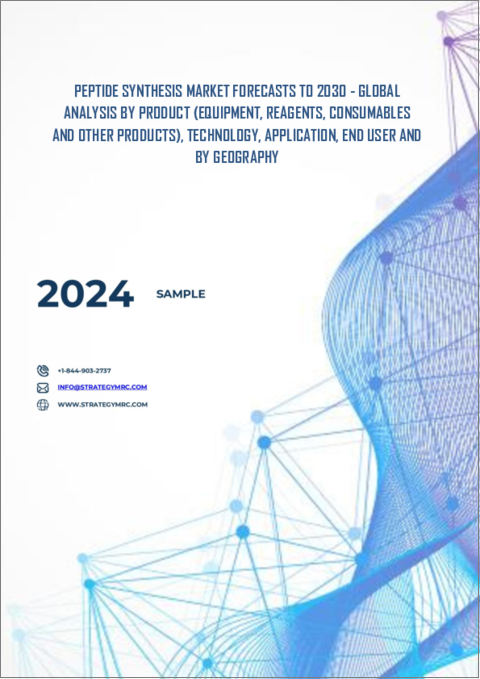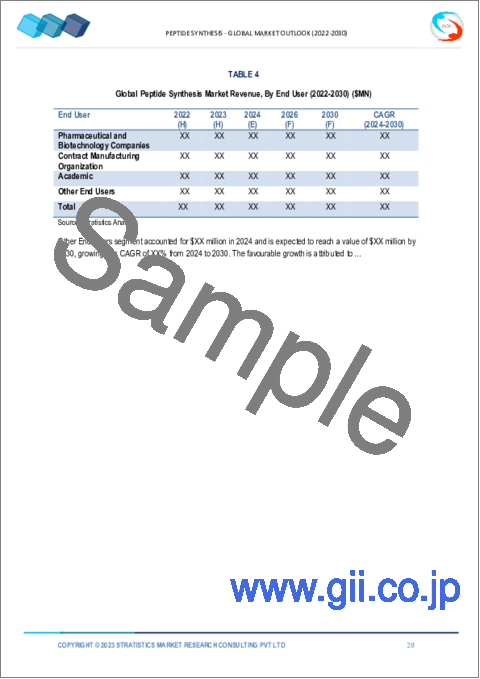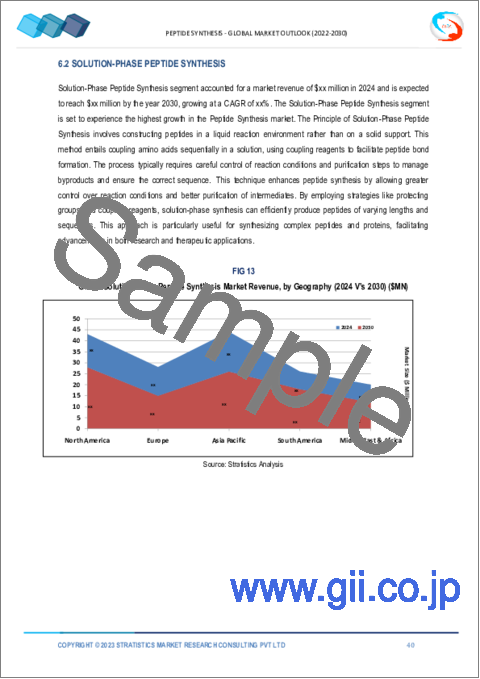|
|
市場調査レポート
商品コード
1401981
ペプチド合成市場の2030年までの予測:製品別、技術別、用途別、エンドユーザー別、地域別の世界分析Peptide Synthesis Market Forecasts to 2030 - Global Analysis By Product (Equipment, Reagents, Consumables and Other Products), Technology, Application, End User and By Geography |
||||||
カスタマイズ可能
|
|||||||
| ペプチド合成市場の2030年までの予測:製品別、技術別、用途別、エンドユーザー別、地域別の世界分析 |
|
出版日: 2023年12月01日
発行: Stratistics Market Research Consulting
ページ情報: 英文 200+ Pages
納期: 2~3営業日
|
- 全表示
- 概要
- 図表
- 目次
Stratistics MRCによると、世界のペプチド合成市場は2023年に51億米ドルを占め、予測期間中のCAGRは10.2%で成長し、2030年には102億米ドルに達すると予測されています。
アミノ酸がペプチド結合で結合した短い鎖であるペプチドを形成する化学プロセスは、ペプチド合成として知られています。アミノ酸をあらかじめ決められた順序で段階的に組み立てる必要があり、反応の制御には特定の官能基の保存が頻繁に必要となります。ペプチドを合成するには、固相合成、溶液相合成、組換えDNA技術などいくつかの方法があります。
ClinicalTrials.govによると、COVID-19の治療薬として21種類のペプチド医薬品が開発中であり、そのうち15種類は急性呼吸窮迫症候群(ARDS)(肺が身体の重要な臓器に十分な酸素を供給できなくなる生命を脅かす状態)、およびSARS-COV-2感染によって引き起こされる他の呼吸器疾患用の合成ペプチドでした。
個別化医薬品の開発
ペプチド合成分野は、オーダーメイド医療の出現により大きな成長が見込まれています。オーダーメイド医療という考え方は、特定の患者プロファイルに合わせてペプチドをカスタマイズする能力によって可能になります。ペプチドは、個別化された治療計画を可能にするために必要なターゲティング、カスタマイズ、特異性を提供します。個別化医療が発展し、普及し続けるにつれて、ペプチド合成技術、サービス、製品に対するニーズが劇的に高まることが予想されます。
投与ルートに関する問題
治療用ペプチドの大部分は、消化管からの吸収が不十分であるため、非経口経路で投与されます。ペプチド医薬品の経口バイオアベイラビリティには限界があり、そのほとんどは全身酵素による分解が原因です。さらに、分子量が大きく、荷電した官能基を持つため、吸収が阻害されることもあります。これらの特徴から、経口投与されるペプチドの大部分は、バイオアベイラビリティが限られており、半減期も短いです。従って、市場にとっては課題といえます。
希少疾患の治療法の進歩
ペプチドは希少疾患や珍しい遺伝的問題を治療できる可能性があります。ペプチド合成分野は、オーダーメイド医療の出現により、大きな成長の見込みがあります。ペプチドは、個別化された治療計画を可能にするために必要な標的化、カスタマイズ、特異性を提供します。個別化医療が発展し普及し続けるにつれて、ペプチド合成技術、サービス、製品に対するニーズが劇的に高まることが予想されます。
精製と品質管理
研究や治療への応用が効果的であるためには、ペプチドは高い純度で得られる必要があります。高速液体クロマトグラフィー(HPLC)は、精製技術の一つであるが、時間がかかる可能性があり、ペプチド配列ごとに最適化する必要があります。合成されたペプチドが正確で一貫性があり安全であるためには、品質管理手順が必要です。効果的な精製手順と高い品質基準を維持することは、市場にとって困難かもしれないです。
COVID-19影響:
パンデミックは、世界中の供給ラインを混乱させることにより、ペプチド合成に必要な原料や機器の入手可能性に影響を与えました。合成されたペプチドの総流通と入手可能性は、生産と出荷の遅れによって影響を受けた。パンデミックは、ヘルスケアの焦点に大きな変化をもたらしました。COVID-19研究に関連した一部のペプチドベースの医薬品やワクチンに対する需要が増加した可能性がある一方、必要不可欠でないヘルスケアサービスの中断により、他のペプチド製品に対する需要が減少した可能性があります。
予測期間中、試薬セグメントが最大となる見込み
予測期間中、試薬セグメントが最大となる見込み。ペプチド合成プロセスは、アミノ酸を化学的に結合させてペプチドを形成します。より迅速で効果的なペプチド結合形成を促進する特定の化学物質を使用することで、合成時間を短縮することができます。副作用や汚染物質を減らし、適切な試薬を使用することで、より純度の高いペプチドを得ることができます。ある種の試薬は、非常に選択性が高いため、望ましくない反応を起こすことなく、アミノ酸の正確なカップリングに役立ちます。
予測期間中、製薬・バイオテクノロジー企業セグメントが最も高いCAGRが見込まれる
製薬・バイオテクノロジー企業セグメントは、予測期間中に最も高いCAGRが見込まれます。ペプチド治療は、毒性が低く、効能があり、費用対効果が高いため、より多くの研究開発の対象となっています。ペプチド合成機の急速な技術向上とペプチド治療の強固なパイプラインが、製薬・バイオテクノロジー企業におけるペプチド合成産業を牽引する主な要因です。
最大のシェアを持つ地域
予測期間中、北米が最大の市場シェアを占めると予測されています。オーダーメイド治療薬の生産拡大、ゲノミクスとプロテオミクスの分野での充実した研究、構造に基づく医薬設計の創出への投資拡大などが、この地域の市場を支えています。さらに、利用しやすいペプチド合成法の認知度の向上により、市場は拡大すると思われます。
CAGRが最も高い地域:
予測期間中、アジア太平洋地域が最も高いCAGRを維持すると予測されます。重要なプレーヤーによる投資の増加により、市場は大きく開拓されると予想されます。さらに、この地域の市場は、新規ペプチド治療に対する意識の高まり、医療費の上昇、より多くの最先端医療施設の利用可能性、新しいペプチド合成技術を生み出すために業界の主要プレーヤーが行った多額の投資によって成長すると予想されます。
無料カスタマイズサービス:
本レポートをご購読のお客様は、以下の無料カスタマイズオプションのいずれかを受けることができます:
- 企業プロファイル
- 追加市場プレイヤーの包括的プロファイリング(3社まで)
- 主要企業のSWOT分析(3社まで)
- 地域セグメンテーション
- 顧客の関心に応じた主要国の市場推計・予測・CAGR(注:フィージビリティチェックによる)
- 競合ベンチマーキング
- 製品ポートフォリオ、地理的プレゼンス、戦略的提携に基づく主要企業のベンチマーキング
目次
第1章 エグゼクティブサマリー
第2章 序文
- 概要
- ステークホルダー
- 調査範囲
- 調査手法
- データマイニング
- データ分析
- データ検証
- 調査アプローチ
- 調査ソース
- 1次調査ソース
- 2次調査ソース
- 前提条件
第3章 市場動向分析
- 促進要因
- 抑制要因
- 機会
- 脅威
- 製品分析
- アプリケーション分析
- エンドユーザー分析
- 新興市場
- 新型コロナウイルス感染症(COVID-19)の影響
第4章 ポーターのファイブフォース分析
- 供給企業の交渉力
- 買い手の交渉力
- 代替品の脅威
- 新規参入業者の脅威
- 競争企業間の敵対関係
第5章 世界のペプチド合成市場:製品別
- 装置
- ペプチド合成装置
- クロマトグラフィー装置
- 凍結乾燥機
- 試薬
- 消耗品
- その他の製品
第6章 世界のペプチド合成市場:技術別
- 溶液相ペプチド合成
- 固相ペプチド合成
- ハイブリッドおよび組換え技術
第7章 世界のペプチド合成市場:用途別
- 治療
- 代謝障害
- がん
- 呼吸器疾患
- 心血管疾患
- 胃腸疾患
- 感染症
- 皮膚科疾患
- 疼痛管理
- 中枢神経系疾患
- 腎疾患
- その他の治療
- 診断
- 研究
- その他の用途
第8章 世界のペプチド合成市場:エンドユーザー別
- 製薬会社およびバイオテクノロジー会社
- 受託製造機関
- 学術
- その他のエンドユーザー
第9章 世界のペプチド合成市場:地域別
- 北米
- 米国
- カナダ
- メキシコ
- 欧州
- ドイツ
- 英国
- イタリア
- フランス
- スペイン
- その他欧州
- アジア太平洋地域
- 日本
- 中国
- インド
- オーストラリア
- ニュージーランド
- 韓国
- その他アジア太平洋地域
- 南米
- アルゼンチン
- ブラジル
- チリ
- その他南米
- 中東とアフリカ
- サウジアラビア
- アラブ首長国連邦
- カタール
- 南アフリカ
- その他中東とアフリカ
第10章 主な発展
- 契約、パートナーシップ、コラボレーション、合弁事業
- 買収と合併
- 新製品の発売
- 事業拡大
- その他の主要戦略
第11章 企業プロファイル
- Biotage
- Genscript Biotech
- Thermo Fisher Scientific
- Merck KGaA
- Creative Diagnostics
- CEM Corporation
- Bachem Holdings
- PuroSynth
- Syngene
- Lonza
- Polypeptide Group
- Novo Nordisk A/S
- MP Biomedicals
- Evonik
List of Tables
- Table 1 Global Peptide Synthesis Market Outlook, By Region (2021-2030) ($MN)
- Table 2 Global Peptide Synthesis Market Outlook, By Product (2021-2030) ($MN)
- Table 3 Global Peptide Synthesis Market Outlook, By Equipment (2021-2030) ($MN)
- Table 4 Global Peptide Synthesis Market Outlook, By Peptide Synthesizers (2021-2030) ($MN)
- Table 5 Global Peptide Synthesis Market Outlook, By Chromatography Equipment (2021-2030) ($MN)
- Table 6 Global Peptide Synthesis Market Outlook, By Lyophilizers (2021-2030) ($MN)
- Table 7 Global Peptide Synthesis Market Outlook, By Reagents (2021-2030) ($MN)
- Table 8 Global Peptide Synthesis Market Outlook, By Consumables (2021-2030) ($MN)
- Table 9 Global Peptide Synthesis Market Outlook, By Other Products (2021-2030) ($MN)
- Table 10 Global Peptide Synthesis Market Outlook, By Technology (2021-2030) ($MN)
- Table 11 Global Peptide Synthesis Market Outlook, By Solution-Phase Peptide Synthesis (2021-2030) ($MN)
- Table 12 Global Peptide Synthesis Market Outlook, By Solid-Phase Peptide Synthesis (2021-2030) ($MN)
- Table 13 Global Peptide Synthesis Market Outlook, By Hybrid & Recombinant Technology (2021-2030) ($MN)
- Table 14 Global Peptide Synthesis Market Outlook, By Application (2021-2030) ($MN)
- Table 15 Global Peptide Synthesis Market Outlook, By Therapeutics (2021-2030) ($MN)
- Table 16 Global Peptide Synthesis Market Outlook, By Metabolic Disorders (2021-2030) ($MN)
- Table 17 Global Peptide Synthesis Market Outlook, By Cancer (2021-2030) ($MN)
- Table 18 Global Peptide Synthesis Market Outlook, By Respiratory Disorders (2021-2030) ($MN)
- Table 19 Global Peptide Synthesis Market Outlook, By Cardiovascular Disorders (2021-2030) ($MN)
- Table 20 Global Peptide Synthesis Market Outlook, By Gastrointestinal Disorders (2021-2030) ($MN)
- Table 21 Global Peptide Synthesis Market Outlook, By Infectious Diseases (2021-2030) ($MN)
- Table 22 Global Peptide Synthesis Market Outlook, By Dermatology Disorders (2021-2030) ($MN)
- Table 23 Global Peptide Synthesis Market Outlook, By Pain Management (2021-2030) ($MN)
- Table 24 Global Peptide Synthesis Market Outlook, By CNS Disorders (2021-2030) ($MN)
- Table 25 Global Peptide Synthesis Market Outlook, By Renal Disorders (2021-2030) ($MN)
- Table 26 Global Peptide Synthesis Market Outlook, By Other Therapeutics (2021-2030) ($MN)
- Table 27 Global Peptide Synthesis Market Outlook, By Diagnosis (2021-2030) ($MN)
- Table 28 Global Peptide Synthesis Market Outlook, By Research (2021-2030) ($MN)
- Table 29 Global Peptide Synthesis Market Outlook, By Other Applications (2021-2030) ($MN)
- Table 30 Global Peptide Synthesis Market Outlook, By End User (2021-2030) ($MN)
- Table 31 Global Peptide Synthesis Market Outlook, By Pharmaceutical and Biotechnology Companies (2021-2030) ($MN)
- Table 32 Global Peptide Synthesis Market Outlook, By Contract Manufacturing Organization (2021-2030) ($MN)
- Table 33 Global Peptide Synthesis Market Outlook, By Academic (2021-2030) ($MN)
- Table 34 Global Peptide Synthesis Market Outlook, By End Users (2021-2030) ($MN)
Note: Tables for North America, Europe, APAC, South America, and Middle East & Africa Regions are also represented in the same manner as above.
According to Stratistics MRC, the Global Peptide Synthesis Market is accounted for $5.1 billion in 2023 and is expected to reach $10.2 billion by 2030 growing at a CAGR of 10.2% during the forecast period. The chemical process of forming peptides, which are short chains of amino acids joined by peptide bonds, is known as peptide synthesis. It entails assembling amino acids step-by-step in a predetermined order, and controlling the reaction frequently necessitates the preservation of particular functional groups. There are several ways to synthesize peptides, including solid-phase synthesis, solution-phase synthesis, and recombinant DNA technology.
According to Clinical Trials.gov, 21 peptide drugs were in development for the treatment of COVID-19, including 15 synthetic peptides for acute respiratory distress syndrome (ARDS), a life-threatening condition in which the lungs are unable to provide enough oxygen to the body's vital organs, and other respiratory illnesses caused by SARS-Cov-2 infection.
Market Dynamics:
Driver:
Development of personalized medicines
The peptide synthesis sector has significant growth prospects due to the emergence of customized medicine. The idea of customized medicine is made possible by the ability to customize peptides to fit certain patient profiles. They provide the necessary targeting, customisation, and specificity to enable individualized treatment plans. It is anticipated that the need for peptide synthesis technology, services, and products will increase dramatically as personalized medicine continues to develop and gain popularity.
Restraint:
Problems related to the administrative route
The majority of therapeutic peptides are administered by the parenteral route because of insufficient absorption from the gastrointestinal tract. Peptide medications have a limited oral bioavailability mostly due to pre-systemic enzymatic breakdown. Additionally, the large molecular weight and charged functional groups of these medicines sometimes impede their absorption. These features result in the majority of peptides taken orally having limited bioavailability and brief half-lives. Hence, it can be considered a challenge for the market.
Opportunity:
Advancement in therapeutics for rare diseases
Peptides could be able to cure orphan illnesses and unusual genetic problems. The peptide synthesis sector has significant growth prospects due to the emergence of customized medicine. Peptides provide the necessary targeting, customisation, and specificity to enable individualized treatment plans. It is anticipated that the need for peptide synthesis technology, services, and products will increase dramatically as personalized medicine continues to develop and gain popularity.
Threat:
Purification and quality control
Peptides must be obtained with a high degree of purity in order for research and therapeutic applications to be effective. High-performance liquid chromatography (HPLC) is one of the purification techniques that might take a long time and need to be optimized for every peptide sequence. For synthesized peptides to be accurate, consistent, and safe, quality control procedures are necessary. The market may find it difficult to maintain effective purification procedures and high standards of quality.
COVID-19 Impact:
The pandemic affected the availability of raw materials and equipment required for peptide synthesis by upsetting supply lines around the world. The total distribution and availability of synthesized peptides were impacted by production and shipping delays. The pandemic caused a major shift in the focus of healthcare. Demand for some peptide-based medications or vaccines associated with COVID-19 research may have increased, while interruptions in non-essential healthcare services may have resulted in a decline in demand for other peptide products.
The reagents segment is expected to be the largest during the forecast period
The reagents segment is expected to be the largest during the forecast period. The process of peptide synthesis entails joining amino acids chemically to form peptides. Synthesis times can be shortened by using certain chemicals that promote quicker and more effective peptide bond formation. By reducing side effects and contaminants, using the right reagent can result in a peptide that is more pure. Certain reagents help with the precise coupling of amino acids without producing undesirable reactions since they are very selective.
The pharmaceutical and biotechnology companies segment is expected to have the highest CAGR during the forecast period
The pharmaceutical and biotechnology companies segment is expected to have the highest CAGR during the forecast period. Peptide treatments are the subject of more study and development because they are less toxic, efficacious, and cost-effective. Rapid technical improvements in peptide synthesizers and a robust pipeline of peptide therapies are the main factors driving the peptide synthesis industry in pharmaceutical and biotechnology firms.
Region with largest share:
North America is projected to hold the largest market share during the forecast period. Growth in the production of customized therapies, substantial research in the fields of genomics and proteomics, and greater investments in the creation of structure-based medicine designs have all helped the regional market. Additionally, the market will expand due to the increased awareness of the accessible peptide synthesis methods.
Region with highest CAGR:
Asia Pacific is projected to hold the highest CAGR over the forecast period. The market is expected to develop significantly as a result of the increase in investments made by important players. Furthermore, it is expected that the region's market will grow due to rising awareness of novel peptide treatments, rising healthcare costs, the availability of more cutting-edge healthcare facilities, and significant investments made by the major players in the industry to create new peptide synthesis technologies.
Key players in the market:
Some of the key players in Peptide Synthesis market include Biotage, Genscript Biotech, Thermo Fisher Scientific, Merck KGaA, Creative Diagnostics, CEM Corporation, Bachem Holdings, PuroSynth, Syngene, Lonza, Polypeptide Group, Novo Nordisk A/S, MP Biomedicals and Evonik.
Key Developments:
In January 2023, Merck announced an agreement to acquire the peptide synthesis company Asymchem. This acquisition will give Merck access to Asymchem's expertise in peptide synthesis and its global manufacturing network.
In December 2022, Thermo Fisher announced an agreement to acquire the peptide synthesis company Protagen. This acquisition will give Thermo Fisher access to Protagen's expertise in peptide synthesis and its global manufacturing network.
Products Covered:
- Equipment
- Reagents
- Consumables
- Other Products
Technologies Covered:
- Solution-Phase Peptide Synthesis
- Solid-Phase Peptide Synthesis
- Hybrid & Recombinant Technology
Applications Covered:
- Therapeutics
- Diagnosis
- Research
- Other Applications
End Users Covered:
- Pharmaceutical and Biotechnology Companies
- Contract Manufacturing Organization
- Academic
- Other End Users
Regions Covered:
- North America
- US
- Canada
- Mexico
- Europe
- Germany
- UK
- Italy
- France
- Spain
- Rest of Europe
- Asia Pacific
- Japan
- China
- India
- Australia
- New Zealand
- South Korea
- Rest of Asia Pacific
- South America
- Argentina
- Brazil
- Chile
- Rest of South America
- Middle East & Africa
- Saudi Arabia
- UAE
- Qatar
- South Africa
- Rest of Middle East & Africa
What our report offers:
- Market share assessments for the regional and country-level segments
- Strategic recommendations for the new entrants
- Covers Market data for the years 2021, 2022, 2023, 2026, and 2030
- Market Trends (Drivers, Constraints, Opportunities, Threats, Challenges, Investment Opportunities, and recommendations)
- Strategic recommendations in key business segments based on the market estimations
- Competitive landscaping mapping the key common trends
- Company profiling with detailed strategies, financials, and recent developments
- Supply chain trends mapping the latest technological advancements
Free Customization Offerings:
All the customers of this report will be entitled to receive one of the following free customization options:
- Company Profiling
- Comprehensive profiling of additional market players (up to 3)
- SWOT Analysis of key players (up to 3)
- Regional Segmentation
- Market estimations, Forecasts and CAGR of any prominent country as per the client's interest (Note: Depends on feasibility check)
- Competitive Benchmarking
- Benchmarking of key players based on product portfolio, geographical presence, and strategic alliances
Table of Contents
1 Executive Summary
2 Preface
- 2.1 Abstract
- 2.2 Stake Holders
- 2.3 Research Scope
- 2.4 Research Methodology
- 2.4.1 Data Mining
- 2.4.2 Data Analysis
- 2.4.3 Data Validation
- 2.4.4 Research Approach
- 2.5 Research Sources
- 2.5.1 Primary Research Sources
- 2.5.2 Secondary Research Sources
- 2.5.3 Assumptions
3 Market Trend Anaysis
- 3.1 Introduction
- 3.2 Drivers
- 3.3 Restraints
- 3.4 Opportunities
- 3.5 Threats
- 3.6 Product Analysis
- 3.7 Application Analysis
- 3.8 End User Analysis
- 3.9 Emerging Markets
- 3.10 Impact of Covid-19
4 Porters Five Force Analysis
- 4.1 Bargaining power of suppliers
- 4.2 Bargaining power of buyers
- 4.3 Threat of substitutes
- 4.4 Threat of new entrants
- 4.5 Competitive rivalry
5 Global Peptide Synthesis Market, By Product
- 5.1 Introduction
- 5.2 Equipment
- 5.2.1 Peptide Synthesizers
- 5.2.2 Chromatography Equipment
- 5.2.3 Lyophilizers
- 5.3 Reagents
- 5.4 Consumables
- 5.5 Other Products
6 Global Peptide Synthesis Market, By Technology
- 6.1 Introduction
- 6.2 Solution-Phase Peptide Synthesis
- 6.3 Solid-Phase Peptide Synthesis
- 6.4 Hybrid & Recombinant Technology
7 Global Peptide Synthesis Market, By Application
- 7.1 Introduction
- 7.2 Therapeutics
- 7.2.1 Metabolic Disorders
- 7.2.2 Cancer
- 7.2.3 Respiratory Disorders
- 7.2.4 Cardiovascular Disorders
- 7.2.5 Gastrointestinal Disorders
- 7.2.6 Infectious Diseases
- 7.2.7 Dermatology Disorders
- 7.2.8 Pain Management
- 7.2.9 CNS Disorders
- 7.2.10 Renal Disorders
- 7.2.11 Other Therapeutics
- 7.3 Diagnosis
- 7.4 Research
- 7.5 Other Applications
8 Global Peptide Synthesis Market, By End User
- 8.1 Introduction
- 8.2 Pharmaceutical and Biotechnology Companies
- 8.3 Contract Manufacturing Organization
- 8.4 Academic
- 8.5 Other End Users
9 Global Peptide Synthesis Market, By Geography
- 9.1 Introduction
- 9.2 North America
- 9.2.1 US
- 9.2.2 Canada
- 9.2.3 Mexico
- 9.3 Europe
- 9.3.1 Germany
- 9.3.2 UK
- 9.3.3 Italy
- 9.3.4 France
- 9.3.5 Spain
- 9.3.6 Rest of Europe
- 9.4 Asia Pacific
- 9.4.1 Japan
- 9.4.2 China
- 9.4.3 India
- 9.4.4 Australia
- 9.4.5 New Zealand
- 9.4.6 South Korea
- 9.4.7 Rest of Asia Pacific
- 9.5 South America
- 9.5.1 Argentina
- 9.5.2 Brazil
- 9.5.3 Chile
- 9.5.4 Rest of South America
- 9.6 Middle East & Africa
- 9.6.1 Saudi Arabia
- 9.6.2 UAE
- 9.6.3 Qatar
- 9.6.4 South Africa
- 9.6.5 Rest of Middle East & Africa
10 Key Developments
- 10.1 Agreements, Partnerships, Collaborations and Joint Ventures
- 10.2 Acquisitions & Mergers
- 10.3 New Product Launch
- 10.4 Expansions
- 10.5 Other Key Strategies
11 Company Profiling
- 11.1 Biotage
- 11.2 Genscript Biotech
- 11.3 Thermo Fisher Scientific
- 11.4 Merck KGaA
- 11.5 Creative Diagnostics
- 11.6 CEM Corporation
- 11.7 Bachem Holdings
- 11.8 PuroSynth
- 11.9 Syngene
- 11.10 Lonza
- 11.11 Polypeptide Group
- 11.12 Novo Nordisk A/S
- 11.13 MP Biomedicals
- 11.14 Evonik






